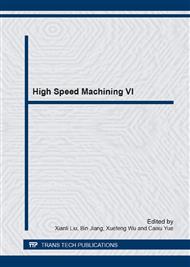p.249
p.254
p.259
p.264
p.269
p.275
p.280
p.285
p.290
Finite Element Simulation Research on a Large Cutting Depth and Quasi-High Speeds 3-D Milling of Titanium Alloys
Abstract:
In this paper, based on finite element software DEFORM, the model of a large cutting depth and quasi-high speeds milling of titanium alloys is built to study the cutting temperature and cutting force variation along with the change of cutting parameters. The simulation results show that: the location of the maximum cutting temperature appears in the cutting edges of the tool nose circular profile. Meanwhile, due to workpiece material rebound in the cutting process, the interface between workpiece and tool flank face occurs serious extrusion, which results in relatively high cutting temperature on the workpiece machined surface. In addition, cutting speed and feed rate per tooth play a key role in influencing the cutting temperature. However, the influence of cutting depth on the cutting temperature is less clear. With the increase in the feed rate and depth of cut, cutting force increased significantly. In particular, within the scope of the cutting speeds under the given conditions, the cutting force has a tendency to decrease with the cutting speed increasing over 120m/min.
Info:
Periodical:
Pages:
269-274
Citation:
Online since:
July 2014
Authors:
Keywords:
Price:
Сopyright:
© 2014 Trans Tech Publications Ltd. All Rights Reserved
Share:
Citation:


